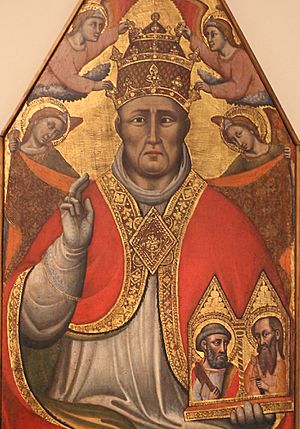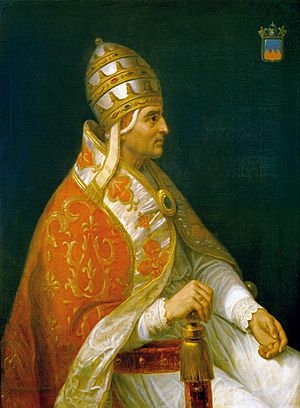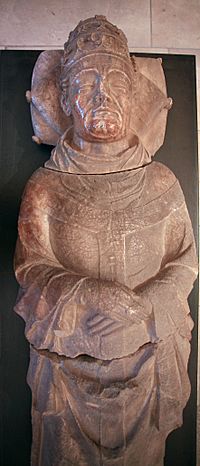Pope Urban V facts for kids
Quick facts for kids Pope Blessed Urban V |
|
|---|---|
| Bishop of Rome | |

Portrait by Simone dei Crocifissi, c. 1375
(National Art Gallery of Bologna) |
|
| Church | Catholic Church |
| Papacy began | 28 September 1362 |
| Papacy ended | 19 December 1370 |
| Predecessor | Innocent VI |
| Successor | Gregory XI |
| Orders | |
| Ordination | 1334 |
| Consecration | 6 November 1362 by Andouin Aubert |
| Personal details | |
| Birth name | Guillaume de Grimoard |
| Born | 1310 Grizac, Languedoc, Kingdom of France |
| Died | 19 December 1370 (aged 59–60) Avignon, Papal States |
| Previous post |
|
| Coat of arms | |
| Sainthood | |
| Feast day | 19 December |
| Venerated in | Catholic Church |
| Title as Saint | Blessed |
| Beatified | 10 March 1870 by Pius IX |
| Attributes |
|
| Patronage |
|
| Other Popes named Urban | |
| Blessed Urban V O.S.B. |
|
|---|---|

Portrait - Henri Auguste Calixte César Serrur.
|
|
| Pope; Confessor | |
| Born | Guillaume de Grimoard 1310 Château de Grizac, Le Pont-de-Montvert, Languedoc, Kingdom of France |
| Died | 19 December 1370 (aged 60) Avignon, Papal States |
| Venerated in | Roman Catholic Church |
| Beatified | 10 March 1870, Saint Peter's Basilica, Papal States by Pope Pius IX |
| Feast | 19 December |
| Attributes | Papal vestments Papal tiara |
| Patronage | Architects Educators Benedictines Missionaries |
Pope Urban V (born Guillaume de Grimoard) was the leader of the Catholic Church from September 28, 1362, until his death in December 1370. He was also a Benedictine monk. He is the only Avignon pope to be declared a "Blessed" person by the Church.
Even after becoming pope, he continued to live a simple life, following the rules of the Benedictine monks. He focused on making reforms during his time as pope. He also worked to restore and build new churches and monasteries. One of his main goals was to reunite the Eastern and Western Christian Churches. He tried hard, like popes before and after him, but he did not succeed.
Contents
Early Life and Education
Guillaume de Grimoard was born in 1310 at the Castle of Grizac in the French region of Languedoc. He was the second son of Guillaume de Grimoard and Amphélise de Montferrand. He had two brothers and one sister.
In 1327, Guillaume became a Benedictine monk at a small monastery called Chirac. This monastery was connected to the old Abbey of St. Victor near Marseille. He was sent to St. Victor for his training as a monk. In 1334, he became a priest in his home monastery.
He studied literature and law at the University of Montpellier. Then, he moved to the University of Toulouse, where he studied law for four years. He earned a special degree in Canon Law (church law) in 1342.
Guillaume became known as an expert in church law. He taught at universities in Montpellier, Paris, and Avignon. He also helped manage church areas for bishops.
Missions to Italy
Guillaume de Grimoard was sent on several important missions to Italy by the popes. These missions aimed to bring peace and order to areas controlled by the Church.
Dealing with Conflicts
In 1352, Pope Clement VI sent Abbot Guillaume to northern Italy. There was a lot of chaos because of the Visconti family from Milan. They had taken over many areas, including the Pope's city of Bologna. Guillaume's job was to try and make a peace agreement. He worked to get Bologna back for the Church.
He was sent to Italy again in 1354, this time to Rome. He helped manage the Church's finances and fix problems in St. Peter's Basilica.
In 1361, he became the abbot of the Abbey of Saint-Victor in Marseille. Even with this new role, he continued to teach as a professor.
Facing Challenges
In 1360, Abbot Guillaume was sent back to Italy to help Cardinal Gil Álvarez Carrillo de Albornoz. They were dealing with Bernabò Visconti, a powerful leader who was causing trouble for the Church. The situation was very tense. Guillaume quickly reported back to the Pope about Visconti's actions.
The Pope sent him back to Italy, but the situation improved when Visconti's army was defeated. After Guillaume became pope, he officially removed Bernabò Visconti from the Church (excommunicated him).
Guillaume returned to his castle in France in 1362. This was because a terrible disease, the plague, was spreading in southern France. Many people, including several important cardinals, died during this time.
Visit to Monte Cassino
In 1362, Guillaume was called to Avignon. On his way, he visited the famous Benedictine abbey of Monte Cassino. He was sad to see how much the abbey had fallen apart. It had been damaged by earthquakes and neglected by church leaders. As soon as he became pope, he worked to fix Monte Cassino. He made sure the abbey was fully controlled by its abbot again.
Becoming Pope
In September 1362, Pope Innocent VI died. Guillaume de Grimoard was in Italy at the time. He was called back to Avignon for the election of the new pope.
The cardinals met on September 22, 1362, in Avignon. Most of them were French. After some discussion, they elected Guillaume Grimoard as the new Pope on September 28. They kept the election a secret for a month. They were worried that the people in Rome, who wanted an Italian pope, might try to stop Guillaume from traveling.
When Guillaume arrived in Avignon, he accepted his election. He chose the name Urban V. He reportedly said that all popes with this name had been saints.
Guillaume was not yet a bishop when he was elected. He had to be made a bishop before he could be crowned. This happened on November 6, 1362. He was then crowned Pope Urban V. He was the sixth pope to live in Avignon.
Pope Urban V's Actions
Reformer and Supporter of Education
As pope, Urban V continued to live simply, following the Benedictine rules. He even kept wearing his monk's robes. He worked to stop bad practices in the Church, like priests not being present in their churches or holding too many church jobs. He also wanted to improve the training of priests.
Pope Urban V made many improvements in how justice was handled. He was also a great supporter of learning and education.
- He started a university in Hungary.
- He gave the University of Pavia special status in 1363.
- He made the Theology Faculty at the University of Toulouse equal to that of the University of Paris.
- In Montpellier, he rebuilt the school of medicine. He also founded a new college there.
- He helped establish the University of Kraków in 1364.
- He provided books and good teachers for many students.
- He even planted vineyards around Rome.
Pope Urban V also protected Jewish people. He said that anyone who harmed them or tried to force them to convert would be removed from the Church.
Military Efforts
One of Urban V's main goals was to bring the papacy (the Pope's office) back to Rome. He also wanted to control powerful rivals in Italy. He sent his brother, Cardinal Angelicus Grimoard, to northern Italy to help.
In 1363, Urban declared a special religious war (crusade) against Bernabò Visconti and his family. They were accused of stealing Church property. However, the Pope later had to make peace with Bernabò.
Urban V also greatly desired a crusade against the Turks. In 1363, King John II of France and King Peter I of Cyprus visited Avignon. They decided to start a war against the Turks. However, gathering an army was very difficult. King John returned to prison in England and died there. King Peter of Cyprus launched a successful attack on Alexandria in 1365, but he did not get much more support. He eventually withdrew after sacking the city.
Return to Rome
Many problems in Italy, along with requests from important people like Petrarch and Bridget of Sweden, convinced Urban V to go to Rome. He arrived in Rome on October 16, 1367. He was the first pope to be in his own diocese in sixty years!
The people and clergy welcomed him joyfully. He was even attended by Emperor Charles IV in St. Peter's Basilica. He also crowned the Empress Elizabeth in 1368. However, it soon became clear that moving the Pope's home did not solve all the problems in Italy.
While in Rome, he met with King Peter I of Cyprus and Queen Joan I of Naples. He also received the Byzantine Emperor John V Palaeologus. Bridget of Sweden, who lived in Rome, warned the Pope that he would die if he left Rome.
Despite the warnings, the French cardinals urged him to return to France. On September 5, 1370, Urban V left Italy by ship. He arrived back in Avignon on September 24. A few days later, he became very ill.
Feeling that he was going to die, he asked to be moved from the Papal Palace. He wanted to be near his brother, Angel de Grimoard, whom he had made a cardinal. He died there on December 19, 1370. He had been pope for eight years. His body was later moved to the monastery of Saint-Victor in Marseille, where he had built a beautiful tomb.
Beatification
Pope Gregory XI began the process to declare Urban V a saint. Urban V's miracles and good deeds were recorded. However, the process stopped for a long time because of a major split in the Church.
Centuries later, the process was restarted. Urban V was declared "Blessed" on March 10, 1870, by Pope Pius IX. His feast day is celebrated on December 19, the day he died.
See also
 In Spanish: Urbano V para niños
In Spanish: Urbano V para niños
- List of popes
- Grimoard



